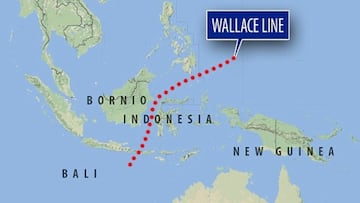What is the Wallace Line: the invisible barrier that fish cannot cross
Scientists still do not understand why some species have failed to cross this barrier, even though others have done so to a lesser extent.

British biologist and naturalist Alfred Russel Wallace gives his name to the Wallace Line, an invisible division that separates two worlds in Southeast Asia, in Indonesia. It is not on any map but marks a zoogeographical border between two ecosystems.
Understanding how they function is key to the biodiversity of species, even more so when climate change is a constant threat to species in Southeast Asia and Australasian regions.
Where is the Wallace line?
It is located between the continents of Asia and Australia. It is a channel of clear and deep waters that separates the Sunda platform and the Sahul platform, which in turn connects Borneo, Bali, Sumatra and Java on one side, and Australia and New Guinea on the other as well as the islands that surround them.
There is no such line on the surface, but below the sea level is the ‘Wallace Trench’, an underwater chasm, which marks the place where the Sunda tectonic plate collides with the Banda and Timor plates.
The “line” barrier is a deep water barrier dating back to the Pleistocene Era (about 50 million years ago).
#OnThisDay in 1858, a seminal journal article comprised of papers by Alfred Russel Wallace FRS and Charles Darwin FRS on the theory of evolution by natural selection was published by the @LinneanSociety, the first public announcement of the theory. https://t.co/xCid7qBpO5 pic.twitter.com/uCVL6vI05g
— The Royal Society (@royalsociety) August 20, 2024
What animals are on each side of the Wallace line?
North of this line, the fauna is made up of elephants, tigers and rhinoceroses. To the south, kangaroos, marsupials and rodents. And these species do not mix. This separation of species developed a theory about the importance of natural barriers (visible or not) in the distribution of species.
The line is very clear for placental mammals or lizards, and it also holds true for many bird species, since most of them do not cross even a small stretch of ocean water. The gap between the islands of Bali and Lombok is only about 22 miles. Some bat species have crossed the line, but most mammals are limited to one side or the other.
As for flora, it doesn't follow the line quite as strictly because the seeds can be blown away by the wind, but even with flora, there is still a significant divide between them and most species of eucalyptus, for example, are only found on the Australian side of the line. There is one exception to this, however: there is one species of eucalyptus that thrives on the Philippine island of Mindanao.
Why don't animals cross the Wallace line?
The main reason would be the lack of opportunities to do so. During past ice-ages, land bridges between the land masses on either side allowed species to migrate to new areas, but no land bridge formed where the Wallace Line is due to the deep trench that runs along it.
Related stories
Likewise, despite the relative proximity of the islands on either side, including the narrowness of the Lombok Strait, the currents between the islands on either side of the line are very strong and animals trying to cross the line would be swept away.
Additionally, in Indonesia there are strict controls on the movement of animals between islands and it is not possible to travel from island to island with wildlife, this is due in particular to the presence of rabies in some parts of the archipelago and not in others.


Complete your personal details to comment